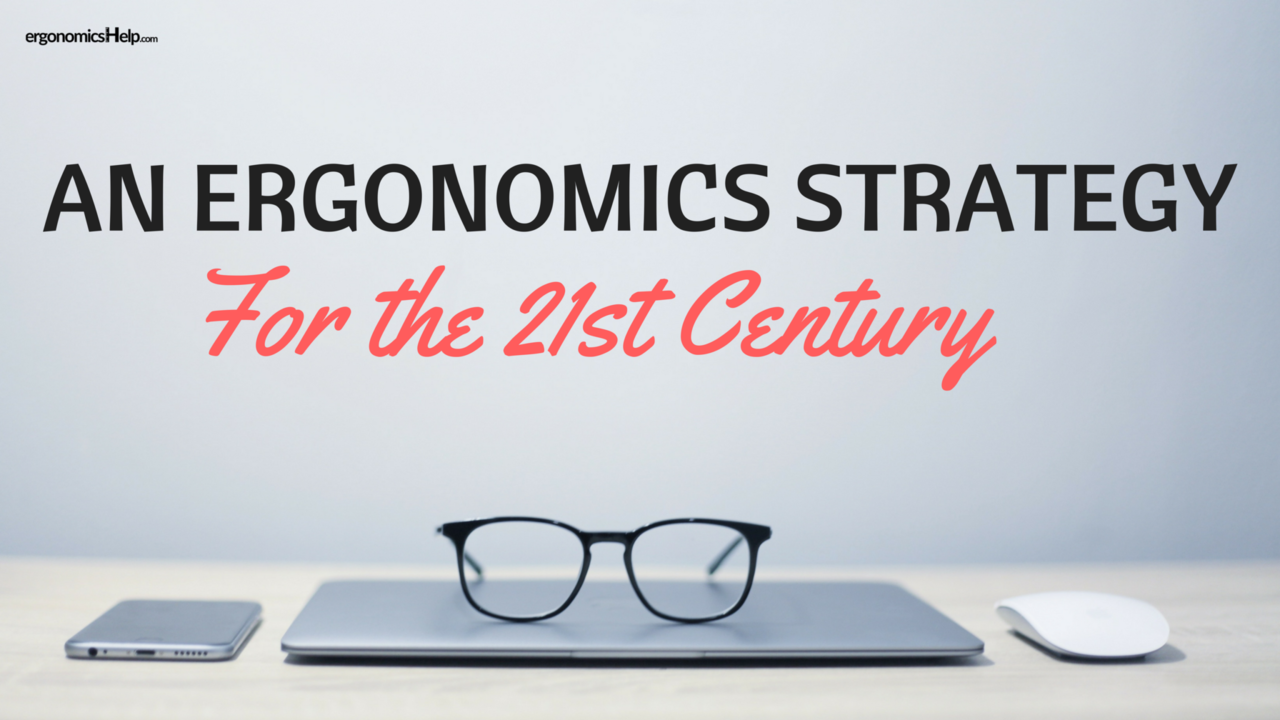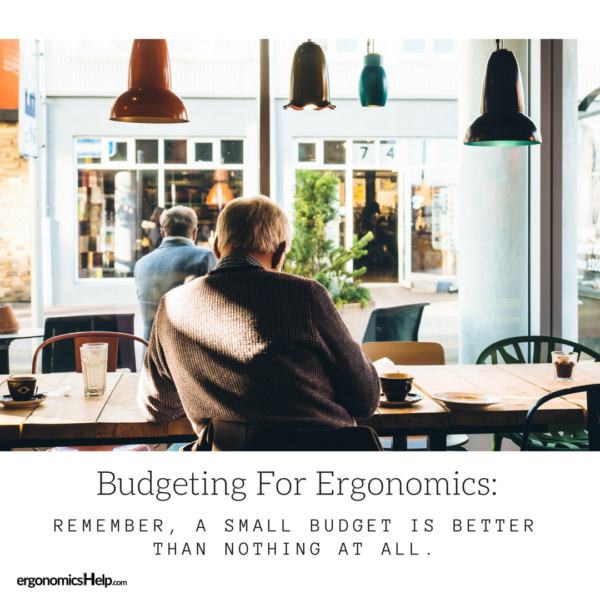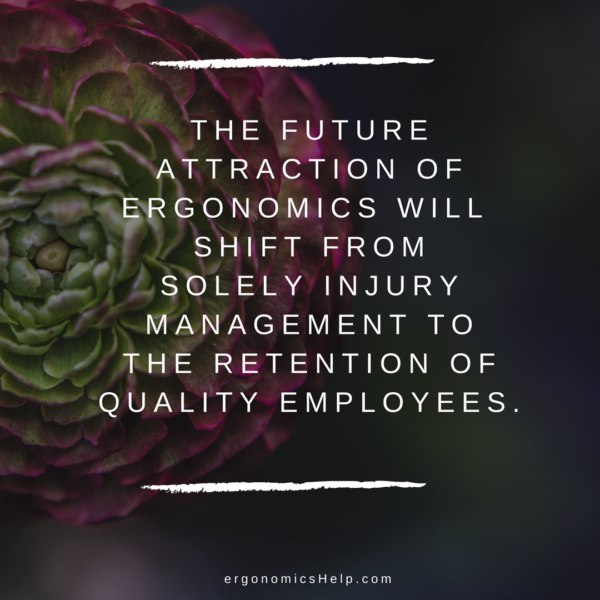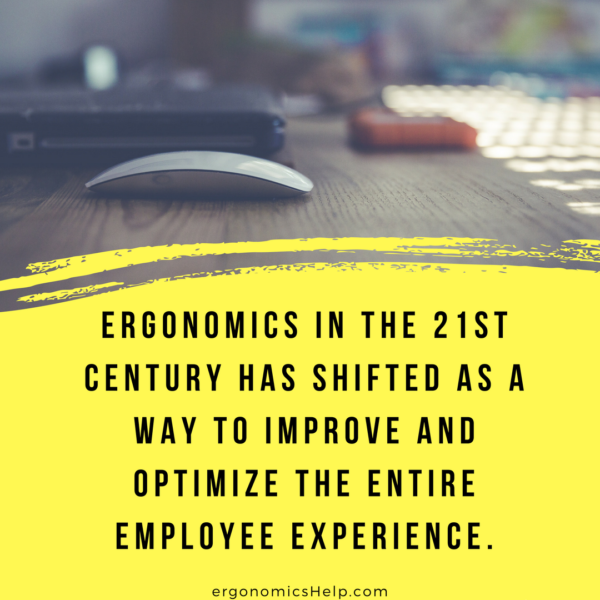An Ergonomics Strategy for the 21st Century
Feb 06, 2019
Here is my prediction for ergonomics in the 21st century. Ergonomics will be all about employee engagement and in-house ergonomics management will be the most cost effective vessel in which to do this.
Here’s why I think this. I’m a seasoned ergonomist and I have both consulted to various companies about ergonomics and managed my own in-house ergonomics program. I managed the in-house ergonomics program of an extremely large organization which ended up being the motivation behind this website! I’ve also taught many companies how to start their own in-house ergonomics program too. All of this has shown me the benefits of keeping ergonomics in-house to keep costs down and keep employees engaged.
From over 10+ years of ergonomics experience I firmly believe that organizations who want to attract and retain the best employees will look at optimizing office ergonomics because there is just so much value with this method. Let me explain more…
The future attraction for ergonomics will shift from the mindset of injury management to proactive/preventative strategies in order to both attract and retain talented employees.
The Cost
Worried about the cost? Remember, ergonomics doesn’t necessarily need to be expensive especially if you focus on adjusting what is already in the workstation instead of jumping to expensive equipment. What about budget? From my experience having even a small budget is better than not identifying a budget in the first place. A budget gives ergonomics assessors parameters to work with when they are looking for solutions. Being proactive and budgeting for ergonomics is always beneficial because the price of a new keyboard will always be cheaper than workers’ compensation claims, lost productivity, and continuously looking for new employees to fill vacated positions.
Having an ergonomics system is just one part of the entire employee experience that any world-class company (without a world-class budget) needs to stay competitive in today’s world.

Employee Engagement
There is intense competition both in hiring and retaining the best employees. The old way of doing ergonomic consultations (via injury management) has huge negative implications for employee health and well-being as well as employee engagement. With using the ‘injury management’ method (aka old way to manage ergonomics) you waited until someone had enough discomfort to justify an ergonomics consultation. By this point that person who is experiencing discomfort would typically lose faith in their organization since they haven’t acted (or noticed) their pain sooner. Or they may not even feel comfortable bringing up their discomfort for the fear that nothing will be done. Or they may feel uncomfortable with the expense of a typical ergonomics assessment.
If you rely on an outside consultant to manage a preventative ergonomics program you could be waiting for them to come in and by doing so miss an opportunity window. So not only is the old way expensive it could be costing you a lot in that person’s injury escalating in the time it takes to schedule an assessment. Imagine investing time and energy in quality employees just to have them seek ‘greener’ pastures – aka those organizations that take employee health more seriously than yours. Tragically, this is more common than many of us would like to admit.
In my experience, organizations will call in outside ergonomic consultants when it’s far too late; it could be that a person already is injured or has a lot of discomfort. But what would happen if you could nip any discomfort in the bud at the first signs? Likely employees will notice this and word will get out quickly that your organization cares about employee wellness. I’ve seen this numerous times in my career.
A really useful approach is to be proactive with ergonomics and use an in-house ergonomics team. In-house ergonomics teams provide a more fine tuned support system that goes hand-in-hand with company ideals. From my experience managing my own in-house ergonomics program, 90% of ergonomics assessments are simple enough that most organizations can do them themselves – if they catch them early enough and if they have the right skills. For those complex cases (aka the other 10%) an ergonomics consultant can always be brought in to assist with the case. In fact I totally recommend it if it is the only barrier holding organizations back from starting their own in-house program! Intuitively it makes sense that having a poor ergonomic set-up will affect how someone feels about their job and organization. However, of course if you ONLY rely on in-house ergonomics programs to be your sole employee engagement strategy, your employees won’t be as nearly as satisfied as they could be. But at the same time, an in-house ergonomics program is better than no engagement tactics at all.
Here’s the thing: if you incorporate ergonomics with wellness, return-to-work, and other initiatives, you can achieve better overall employee engagement. In many ways it’s the last piece of the puzzle for engagement and thereby not seeking out ‘greener pastures’.

The 21st Century
You’ve heard of various health initiatives in today’s workforce that improve employee performance while targeting wellness. Ergonomics in the 21st century is no different. Providing employees with workstations that are set-up to fit them optimally and taking a proactive approach to any employee discomfort is the new normal for modern workplaces. It really adds a lot of value to the employee experience. Focusing on injury indicators and bringing in outside ergonomic consultants for each preventative type of assessment can be incredibly expensive even though it is a ‘good thing’. That’s where in-house ergonomics programs come into play. There is real value in using a simple strategy in ergonomics that can address up to 90% of the discomfort in the organization and then hiring outside ergonomics help for those cases that are too complex. What holds many organizations back from doing this is that they think the ergonomic process is complex and confusing. I’m here to tell you that it doesn’t need to be this way.
Ergonomics is a lot simpler when it’s based on a prevention mindset and executed with core ergonomic principles. The value in this approach is that it’s truly proactive and preventative that narrows in on employee discomfort so simple changes can prevent discomfort from escalating. Using a simple approach can easily address 90% of the discomfort in a workplace. Any ergonomic problem outside this scope? No problem. Hire an outside ergonomics expert for those cases that are too complex. This method saves cost while ensuring that you can nip ergonomic problems in the bud.
To Conclude
If you decide to take preventative and proactive steps via your organization’s ergonomic program not only will you be taking the steps to prevent costly time-loss injuries, you are going to be adding so much value to the entire employee experience… and word of mouth can spread quickly in attracting your ideal employees.

